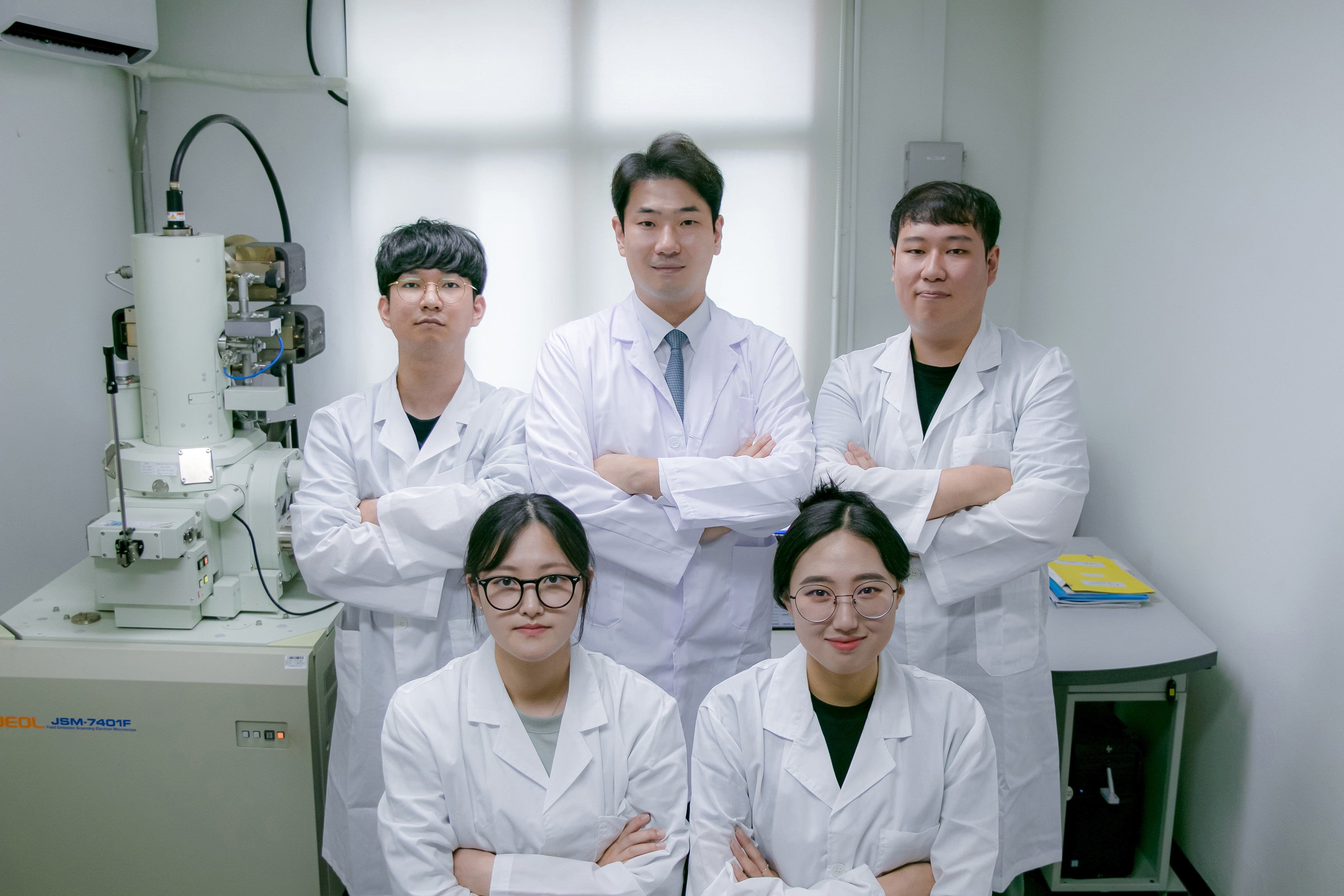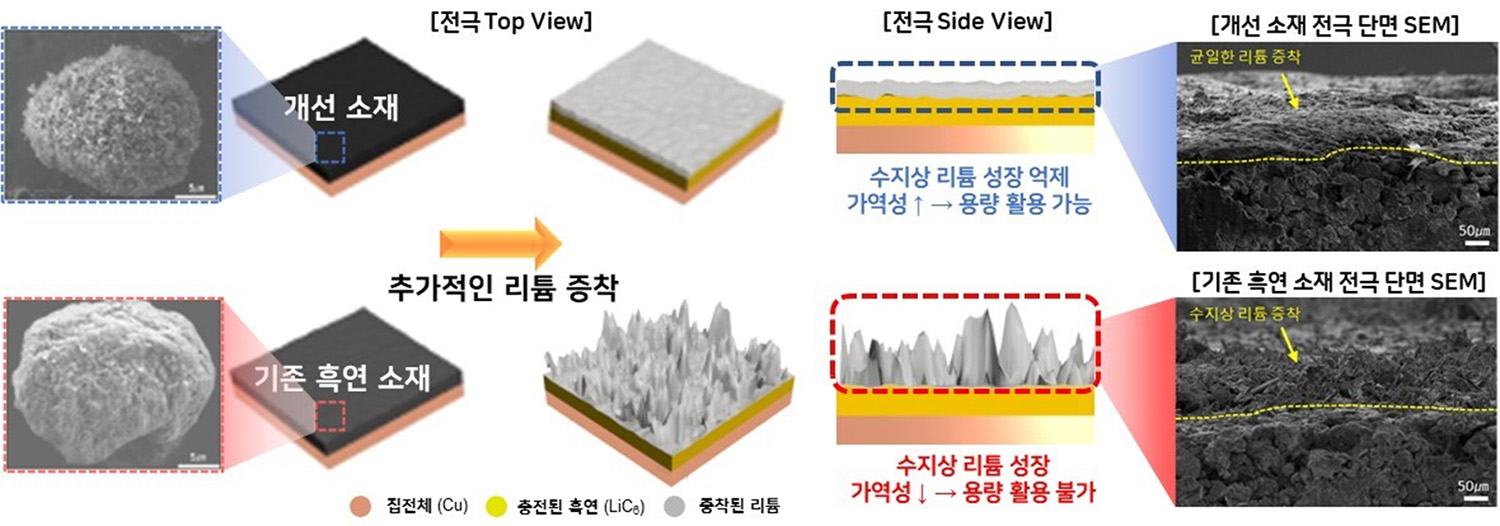커뮤니티
부경투데이
- 국립 부경대학교의 다양한 모습과 소식을 접하시면 부경대학교가 한번 더 가까워집니다.
| 이차전지 결함, 강점으로 승화시켰다(Turning defects of secondary batteries into strengths) | |||
| 작성자 | 대외협력과 | 작성일 | 2022-07-11 |
| 조회수 | 555 | ||
| 이차전지 결함, 강점으로 승화시켰다(Turning defects of secondary batteries into strengths) | |||||
 |
대외협력과 |  |
2022-07-11 |  |
555 |
‘이차전지 폭발위험 물질로 추가 용량 확보’ 역발상 연구 ‘주목’
- 부경대 고민성 교수, 국제학술지 <Journal of Materials Chemistry A> 논문 게재

△고민성 교수(뒤 가운데)와 연구팀.
이차전지의 화재나 폭발 등의 주요 원인으로 알려진 물질을 이용해 오히려 전지의 추가적인 용량을 확보하는 역발상 연구가 관심을 끌고 있다.
국립부경대학교는 고민성 교수(금속공학전공) 연구팀이 흑연 음극재에 결함이 있는 탄소 나노 튜브 성장을 유도해 흑연 음극재의 용량을 초과하는 충전 진행 시 흑연 표면에 형성되는 리튬을 효과적으로 제어하고 이를 용량으로 활용하는 연구 결과를 제시했다고 밝혔다.
이차전지의 흑연 음극재는 용량이 낮은 단점 외에도 과도하거나 불균일한 충전 진행 시 흑연 표면에 수지상(樹枝狀) 리튬 형성이 문제점으로 제시되고 있다. 수지상 리튬은 가역성이 낮아 전지 성능의 열화를 일으키고, 지속적인 성장 시 전기적 단락으로 인한 화재나 폭발의 위험성 때문에 전지 안전성을 저해시키는 주요 원인으로 알려져 있다.
고민성 교수 연구팀은 매사추세츠 공과대학교(MIT) 성재경 박사, 퍼시픽 노스웨스트 국립 연구소(PNNL) 김남형 박사와 공동 연구를 진행해 전지 안정성을 위협하는 수지상 리튬으로 흑연 음극재의 용량 한계를 극복하는 방안을 밝혔다. 결함을 강점으로 승화시킨 것.
연구팀은 니켈 촉매와 탄화수소 가스를 사용하는 화학기상증착(Chemical Vapor Deposition) 공정으로 흑연 표면에 의도적으로 구조적 결함이 있는 탄소 나노 튜브의 성장을 유도했다. 이 소재를 음극에 적용했을 때 리튬의 전착으로 인해 발생하는 전극 저항이 완화되면서 리튬 증착이 균일하게 유도되는 것을 확인했다.
실험 결과 이렇게 유도된 균일한 리튬층은 높은 가역성을 보이며 추가적인 용량으로 작동하는 것으로 나타났다. 양극 전극의 용량이 음극 전극의 용량보다 크게 설계된 완전 전지(full cell) 구동 시 300 사이클 이후에도 가역적인 용량으로 활용할 수 있었다.
고 교수는 “결함이 있는 탄소 나노 튜브가 수지상 리튬을 효과적으로 제어해 전지 안정성 문제를 해결함으로써 전극 설계 시 불필요한 음극 사용을 감소시키고, 동시에 추가적인 리튬 사용으로 전지 에너지 밀도 향상이 가능할 것으로 기대한다.”라고 말했다.
한편 이번 연구는 한국산업기술평가관리원, 한국연구재단의 지원을 받아 이루어졌으며, 재료·에너지 분야 국제학술지인 <Journal of Materials Chemistry A> (IF=12.732)에 최근 게재됐다. <부경투데이>

△모식도 이미지(정상적인 충전 이후 추가적인 리튬 충전 시 표면에 형성되는 수지상의 리튬 성장을 제어하는 개선 소재가 적용된 음극 전극과 기존 흑연 전극)

△ 고민성 교수 연구팀의 연구 장면.
Contrarian research for 'securing additional capacity with explosive hazardous material in secondary batteries'
- Prof. Ko Min-Seong of PKNU published a thesis in the international scientific journal <Journal of Materials Chemistry A>
Contrarian research that can secure additional battery capacity by using a material known as the main cause of fire or explosion of secondary batteries is attracting attention.
Pukyong National University announced that in case of overcharging exceeding the capacity of the graphite anode by leading the growth of defective carbon-nanotubes in the graphite anode, Prof. Ko Min-Seong (dept. of metallurgical engineering)'s team conducted research to effectively control the lithium formed on the graphite surface and utilize this as a battery capacity.
In addition to the disadvantage that the graphite anode material of the secondary battery has a low capacity, the formation of dendrite lithium on the graphite surface has been raised as a problem when overcharged or non-uniformly charged continuously. It is known that dendrite lithium causes deterioration of battery performance because of its low reversibility, and is known to be a major cause of deterioration of battery safety due to the risk of fire or explosion due to electric short circuit when continuously growing.
Professor Ko Min-Seong's research team conducted joint research with Dr. Sung Jae-Kyung from the Massachusetts institute of technology (MIT) and Dr. Kim Nam-Hyung from Pacific Northwest National Laboratory (PNNL) to find a way to overcome the capacity limit of graphite anode materials with dendrite lithium, which threatens the stability of the battery. Their research turned flaws into strengths.
The research team promoted the growth of carbon nanotubes with structural defects on the graphite surface by using a chemical vapor deposition process using a nickel catalyst and hydrocarbon gas. When this material was applied to the negative electrode, the research team confirmed that the lithium deposition was uniformly induced as the resistance of the electrode caused by the electrodeposition of lithium was alleviated.
As a result of the experiment, it was found that the uniform lithium layer induced in this way showed high reversibility and operated with additional battery capacity. When driving a full cell in which the capacity of the positive electrode was designed to be larger than that of the negative electrode, the reversible capacity could be used even after 300 cycles.
Professor Ko said, "I expect that defective carbon nanotubes can effectively control dendrite lithium to solve the battery stability problem, thereby reducing the unnecessary use of negative electrodes in electrode design, and at the same time improving battery energy density by using additional lithium."
The research was supported by the Korea evaluation institute of industrial technology (KEIT) and National Research Foundation of Korea (NRF), and was recently published in <Journal of Materials Chemistry A> (IF=12.732), an international academic journal in the field of materials and energy. <Pukyong Today>